Elm Vs. Oak Differences, Similarities, Pros & Cons
Elm and oak are two popular hardwoods commonly used in furniture making and other woodworking projects. Being hardwoods, they are both resilient and durable.
But what are the elm vs. oak differences? The main difference between elm and oak is the hardness level. This is because Elm is a soft hardwood. The trees also differ in the number of species, color and appearance, scent, and ease of working with. Apart from that, their prices per board foot, medicinal usage, and lifespan are different.
So then, which is the best option? Below, we will look at their differences, similarities, pros, and cons to help you decide which is better.
Elm Vs. Oak Comparison Table
Before we dive into the main guide, let’s quickly check out the elm and oak differences.
| Elm | Oak | |
|---|---|---|
| Species | 30 to 40 | About 500 |
| Hardness Level | 830 lbf | 1,290 to 1,350 lbf |
| Color and Appearance | Dark green leaves andgray brown or darkish brown bark. | Dark, shiny green leaves with whitish underside and light gray or blackish bark |
| Ease of Working With | Tough to work with unless using power tools. | Easy to work with using power or hand-carved tools. |
| Scent | Strong and smoky smell, but little odor when dry. | Bittersweet and earthy smell. |
| Pricing | Cheaper | Expensive |
| Medicinal Uses | Treating severe diarrhea, digestive disorders, and open wounds. Also used as a diuretic. | Treating toothache, burns, and gastropathy. Also used as antiseptic, inflammatory, and hemostatic agent. |
| Lifespan | 100 to 150 years. | 100 to 300 years. |
Elm Vs. Oak Differences
Elm and oak are popular woods or trees often used for furniture construction and other wooden items. But what are their differences? Let’s find out.
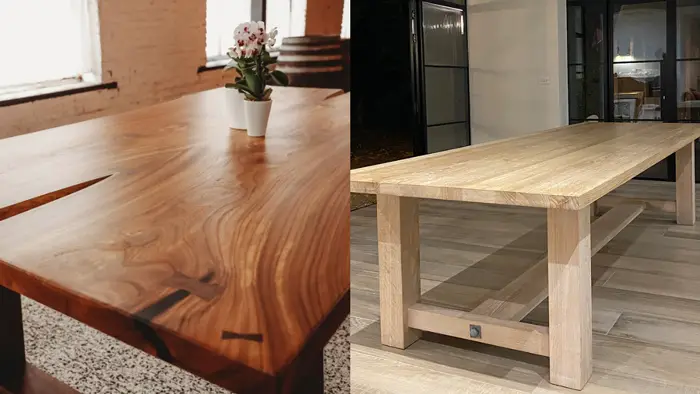
1. Species
Elm is a species of deciduous and semi-deciduous trees in the genus Ulmus and the Ulmaceae family. And overall, there exist about 30 to 40 species of elm that range from ornamental to shade trees.
Conversely, oak is a tree in the genus Quercus of the beech family, and there are about 500 extant oak species. The species range from timber to ornamental trees and shrubs.
2. Hardness
Elm wood has a Janka hardness rating of approximately 830 lbf or 3,692 N. This makes it a soft hardwood.
On the other hand, the Northern red oak has a Janka hardness rating of 1,290 lbf. However, the white oak has a rating of 1,350 lbf, making it the hardest oak species available.
3. Color and Appearance
Elm trees boast dark green, toothed leaves, which typically turn dull yellow or golden yellow in the fall. The bark is gray-brown or darkish-brown with deep ridges. Similarly, elmwood has light to medium reddish-brown heartwood colors and white or grayish-white sapwood.
As for the oak tree, it boasts dark, shiny green leaves on the upper with a whitish underside. And during the fall, the leaves usually turn yellow or rusty brown, depending on the species. Based on the oak’s variety, the bark can be light gray or almost black.
4. Ease of Working With
Elm has a twisted, interlocking grain, making it tough to work with anything apart from power tools. It also does not split when nailed or screwed. Therefore, it requires drilling pilot holes.
Unlike elm, oak has a straight grain, making it easier to work and machine with minimal effort. It is easy to cut and split. In addition, oak finishes nicely with machine or hand-carved tools.
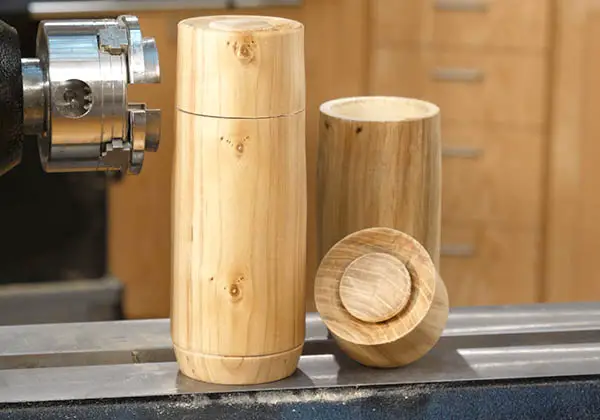
5. Scent
When green, elm boasts a strong, smoky, and unpleasant smell. But once dry, it has little odor.
On the other hand, oak has a powerful, bittersweet, and earthy scent. As such, the tree holds a special place in the hearts of many perfumers. However, fresh red oak produces a vinegar smell when it burns.
6. Pricing
Generally, elm is cheaper than oak, regardless of the species. This is because the price of kiln-dried red elm ranges from $2.70 to $8.50, depending on the size per board foot. However, kiln-dried, white oak costs between $5.75 and $16.35 per board foot.
7. Medicinal Uses
Elm bark is commonly used for severe diarrhea and digestive disorders. Sometimes, it is used for cleaning festering or open wounds. It is also used to reduce water retention as a diuretic.
On the other hand, oak bark is used as a hemostatic and antiseptic. It is also used to treat toothache and gastropathy. In addition, the bark can be used as a healing agent in burns and a pacifying agent in inflammations.
8. Lifespan
Elm trees have an average lifespan of 100 to 150 years or about 15 decades. The lifespan varies based on the tree species. Some species, like the Chinese elm, only live for 50 years.
Conversely, the average lifespan of oaks is about 100 to 300 years, depending on the species. However, some species, like the water oak, are short-lived as their lifespan ranges between 30 and 50 years.
What Are The Similarities Between Elm and Oak?
While elm and oak differ in several ways, they also share some similarities. These include:
Origin
Elm and oak trees are native to the northern hemisphere. They inhabit Asia, Europe, and North America regions.
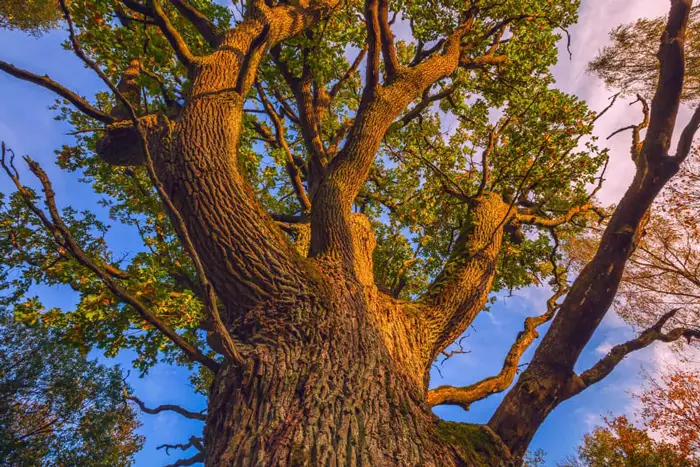
Many Applications
Elm and oak are solid and durable woods. As such, they are commonly used for constructing furniture. In addition, elm is used to make farm buildings, boat parts, wooden water pipes, coffins, and floorboards. As for oak, it can be used for decking, veneers, flooring, joinery, and paneling.
Diseases
Both trees are threatened by fungal diseases. For example, the elm trees are affected by the Dutch elm disease, which causes them to wilt and eventually die. On the other hand, oak trees are threatened by conditions such as Armillaria root rot, oak leaf blister, and oak wilt.
Size
Elm and oak trees grow about the same size. Depending on the species, both trees can grow between 50 and 100 feet tall or more.
Water and Decay Resistance
Elm wood has excellent water resistance properties thanks to its interlocking grain pattern. It is also decay-resistant as long as it is permanently submerged in water.
Oak is also impervious to water thanks to its dense and non-porous texture. This helps protect it from warping. The wood is also decay-resistant. This makes both woods ideal for outdoor projects.
What Are The Pros and Cons of Elm?
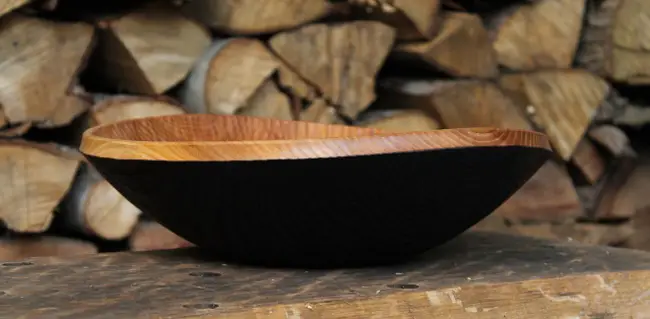
Elm is an excellent wood, and each species has its advantages and disadvantages. Below is a collective list of elm pros.
- Strong and durable
- Water-resistant
- Moderately priced
- Does not split or crack easily, making it best for carving
- Lightweight
- Odor-free and stain-resistant
The drawbacks of elm include the following:
- Susceptible to insect infestation and rot
- Not easy to dry
- Tougher to work with using hand tools
What Are The Pros and Cons of Oak?

Like elm, oak has many pros and cons, regardless of the tree species you choose. The pros include:
- More durable and long-lasting than elm
- Highly resistant to water, rot, and warping
- Naturally resists mold, insects, and fungus
- Best for exterior uses
- Easy to bend and work with using hand and power tools
Let’s now look at the drawbacks of using oak.
- Relatively more expensive than elm
- Heavyweight
- Darkens over time
- Has high levels of tannin, making screws and nuts prone to rusting
Which Is Better: Elm Vs. Oak?
With oak being denser and more durable than elm, oak is a preferred wood for many construction projects. Besides, it is easy to work with whether using hand or power tools.
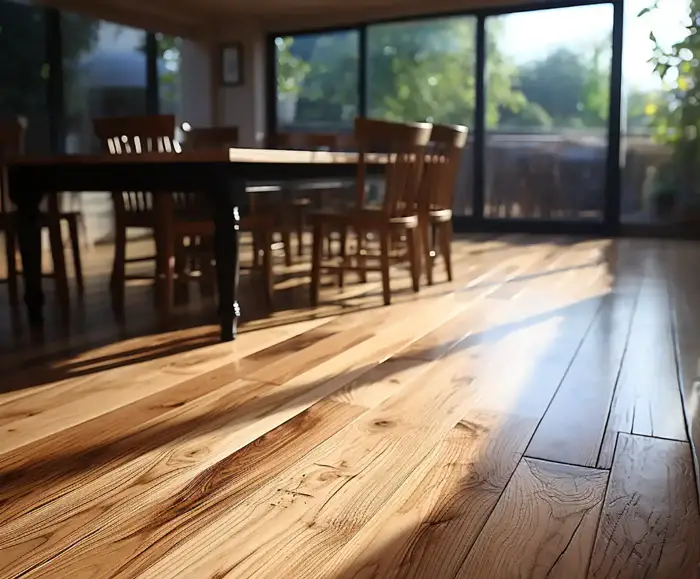
However, if you are looking for a more affordable option that is still robust and long-lasting, elm is an excellent choice. It is durable underwater, making it ideal for constructing boats. In addition, it is stable once dried, relatively elastic, and resistant to splitting.
If you’re in the process of choosing between elm and oak for your woodworking project and need guidance, our guide on how to remove alcohol stains from wood might also provide insights into wood care and maintenance. Additionally, if you’re comparing tung oil vs shellac finishes and need to make an informed choice, our comparison guide on tung oil vs shellac could help you understand the characteristics and applications of these finishes. We understand the importance of selecting the right wood and finishes for your projects, and our comprehensive resources are designed to help you navigate and make informed choices.FAQs
In this section, we will respond to frequently asked queries about elm vs. oak differences.
Q: Does elm require more care and maintenance than oak?
No. While oak is more durable than elm, it requires more care and maintenance once it has been turned into flooring or furniture. This is because it is more prone to splintering and cracking than elm.
Q: Which is more sustainable, elm or oak?
Both trees are highly sustainable as long as they are sourced responsibly, thanks to their fast-growing rate. Therefore, it is possible to harvest the wood for a long time without causing harm to the forests.
Q: Does elm stain better than oak?
No. Oak wood is more effortless to stain than elm because of its open-grain structure and larger pores. As such, stains easily penetrate deep into the pores. Elm has an interlocking grain pattern, which is tighter, and the pores are smaller, making staining tough.
Conclusion
It can be hard to tell the differences between elm and oak at first sight. Therefore, knowing their differences is critical if you plan to use one of them in your woodworking projects. Some ways to differentiate the two are their scent, hardness, pricing, color, and appearance.
Now, besides their differences, these two tree species have many similarities. For example, they grow about the same size and are susceptible to diseases. In addition, elm and oak have different pros and cons. But overall, oak seems to be a better choice than elm due to its durability.




